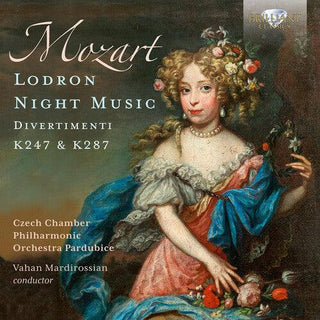Czech Chamber Philharmonic Orchestra Pardubice- Mozart: Lodron Night Music - Divertimenti K247 & 287

Mozart wrote the Divertimento K247 in June 1776 for the name-day of Countess Maria Antonia Lodron, a family friend whose two daughters were pupils of the composer. He went on to write the Concerto for Three Pianos with the countess and her daughters as the intended soloists. Meanwhile K247 displays the 19-year-old composer's lyrical gifts but also his structural sophistication and his unerring feel for instrumental sonorities. K287 followed in 1777 as a direct sequel, composed for the same occasion and the same forces, and cast in comparably expansive terms across six movements. The intervening year seems to bring a refinement of both craft and humour, for K287 is one of the miracles of Mozart's lighter music, touched with high contrasts, memorable themes and sturdy developments. The second movement is a genial Andante and Variations which instantly transcends it's 'occasional' context. The heart of the work is the Adagio, placed fourth, where the solo violin outlines a melody cast from the same mould as the slow movement of the G major Violin Concerto K216 from two years earlier. But then Mozart comes up with a genuinely funny musical joke at the start of the finale, where the strings paint a recitative without words, like a virtual soprano on an empty stage. Testifying to their adaptability, these divertimenti have attracted performances and recordings by forces ranging from the one-per-part Vienna Octet to Karajan's Berlin Philharmonic. This new recording presents an attractive middle way, infused with vigour and charm by the Czech Chamber Philharmonic Orchestra of Pardubice under the baton of the Armenian conductor Vahan Mardirossian. Mardirossian and his Czech colleagues have made several successful albums together, including the serenades by Dvorák on Brilliant Classics (97030). Their recording of these perennially appealing early-Mozart works is accompanied by a new essay from Mark Viner.
Mozart wrote the Divertimento K247 in June 1776 for the name-day of Countess Maria Antonia Lodron, a family friend whose two daughters were pupils of the composer. He went on to write the Concerto for Three Pianos with the countess and her daughters as the intended soloists. Meanwhile K247 displays the 19-year-old composer's lyrical gifts but also his structural sophistication and his unerring feel for instrumental sonorities. K287 followed in 1777 as a direct sequel, composed for the same occasion and the same forces, and cast in comparably expansive terms across six movements. The intervening year seems to bring a refinement of both craft and humour, for K287 is one of the miracles of Mozart's lighter music, touched with high contrasts, memorable themes and sturdy developments. The second movement is a genial Andante and Variations which instantly transcends it's 'occasional' context. The heart of the work is the Adagio, placed fourth, where the solo violin outlines a melody cast from the same mould as the slow movement of the G major Violin Concerto K216 from two years earlier. But then Mozart comes up with a genuinely funny musical joke at the start of the finale, where the strings paint a recitative without words, like a virtual soprano on an empty stage. Testifying to their adaptability, these divertimenti have attracted performances and recordings by forces ranging from the one-per-part Vienna Octet to Karajan's Berlin Philharmonic. This new recording presents an attractive middle way, infused with vigour and charm by the Czech Chamber Philharmonic Orchestra of Pardubice under the baton of the Armenian conductor Vahan Mardirossian. Mardirossian and his Czech colleagues have made several successful albums together, including the serenades by Dvorák on Brilliant Classics (97030). Their recording of these perennially appealing early-Mozart works is accompanied by a new essay from Mark Viner.





